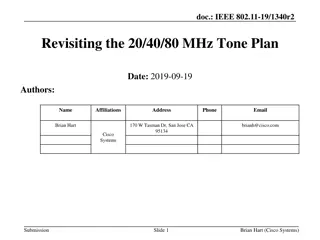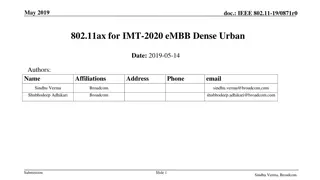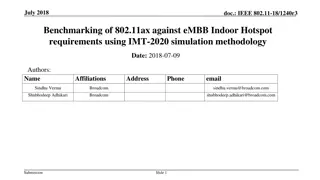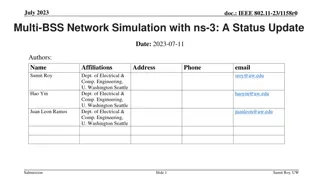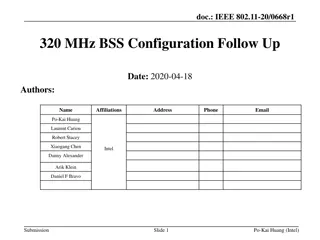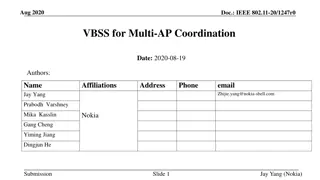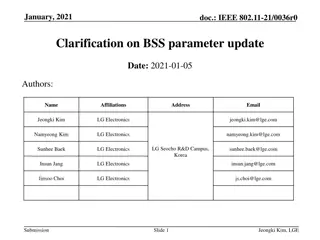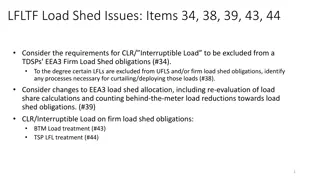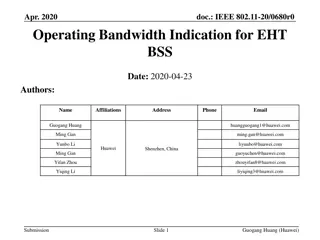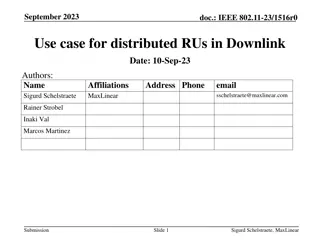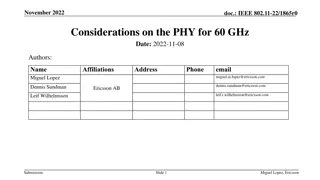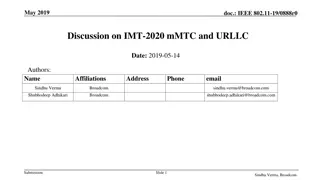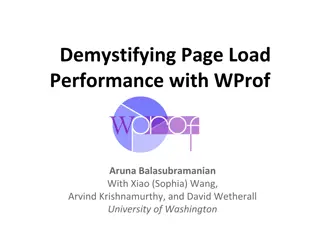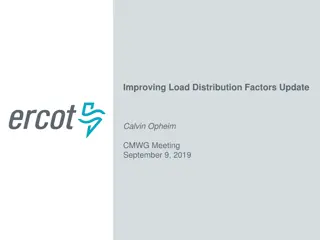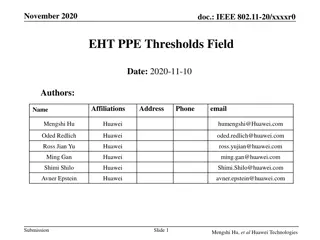Enhancing BSS Load Management in 802.11ax Networks
Proposed changes to address load balancing issues in dense 802.11ax scenarios by introducing a new information element for BSS Load. The new element considers OFDMA utilization, UL/DL MU-MIMO, and allows for future extensions to ensure efficient AP selection by unassociated STAs. Enhancements aim to improve channel utilization and spatial stream allocation, especially in the context of OFDMA. Comparison with 802.11ac's BSS load handling is provided.
Download Presentation

Please find below an Image/Link to download the presentation.
The content on the website is provided AS IS for your information and personal use only. It may not be sold, licensed, or shared on other websites without obtaining consent from the author. Download presentation by click this link. If you encounter any issues during the download, it is possible that the publisher has removed the file from their server.
E N D
Presentation Transcript
March 2017 802.11-17/361 r0 BSS Load Information in 802.11ax Date: 2017-03-xx Authors: Name Affiliation Address Phone Email F1-17, Huawei Base, Bantian, Shenzhen F1-17, Huawei Base, Bantian, Shenzhen Ming Gan ming.gan@huawei.com David X. Yang +86-15914117462 david.yangxun@huawei.com Huawei Submission Slide 1 Ming Gan et al. (Huawei) Ming Gan et al. (Huawei)
March 2017 802.11-17/361 r0 Load Balancing Problem STAs normally prefer to access best AP with strongest received power. In 802.11ax, there will be a large number of STAs and traffic in dense scenarios. Some AP may be associated with too many STAs and/or over-loaded. If STAs choose the busy AP, they have less opportunity of scheduled transmission. Load unbalancing problem is getting more serious in 802.11ax dense scenarios. Submission Slide 2 Ming Gan et al. (Huawei)
March 2017 802.11-17/361 r0 Comments on Loading Balancing Problem CID P.L Clause Comment Proposed Change Add a new information element to define 11ax BSS Load. The new IE shall address utilization status of OFDMA as well as UL/DL MU MIMO, as well as provisions to allow future extensions. With the introduction of new features such as OFDMA and UL MU MIMO, the existing BSS load elements (9.4.2.160 & 9.4.2.28), which address STA numbers, primary/secondary channel busy condition and DL MU-MIMO underutilization (11ac) are not sufficient for addressing the BSS load status in a 11ax BSS. A further enhanced BSS Load element needs to be defined. BSS load element provides the channel utilization such that the unassociated STA can choose the proper AP + and extended BSS load element further provides the spatial stream underutilization given the busy channel such that unassociated STA with MU-MIMO capability can choose the proper AP. Now 11ax introduce a OFDMA, there is the probability of frequency underutilization given the busy channel. 5917 67.01 9.4.2 Define a HE BSS load element considering frequency utilization such to help unassociated STA to choose a best AP 8165 67.01 9.4.2 Submission Slide 3 Ming Gan et al. (Huawei)
March 2017 802.11-17/361 r0 BSS load information in 802.11ac In 802.11ac, MU-MIMO spatial stream underutilization have been considered in the Extended BSS Load element of the Beacon frame STAs use it for implementation-specific AP selection. However, the frequency utilization is only calculated on primary 20MHz and secondary 20/40/80MHz since OFDM with SU/MU-MIMO is supported in 802.11ac. In 802.11ax, OFDMA together with SU-MIMO on each RU and MU- MIMO on RU>=106 are supported. 802.11ax with OFDMA+SU/MU-MIMO 802.11ac with SU/MU-MIMO f f 4STA with 2SSs per STA on 242-RU 2STA with 2SSs per STA Secondary 40MHz 4STA with 1SS per STA on 106-RU Secondary 20MHz 2STA with 1SS per STA on 242-RU Primary 20MHz t t busy busy idle busy busy idle Submission Slide 4 Ming Gan et al. (Huawei)
March 2017 802.11-17/361 r0 Objective We propose to consider resource utilization of each 20 MHz channel and Frequency and spatial stream underutilization of OFDMA and SU/MU-MIMO on each 20 MHz channel for load balancing in 802.11ax. Resource dimensions {time, frequency, space} frequency-domain: each 20MHz-CH instead of primary 20, secondary 20/40/80MHz only space-domain: SU/MU-MIMO spatial streams on OFDMA RUs instead of that on whole BW Submission Slide 5 Ming Gan et al. (Huawei)
March 2017 802.11-17/361 r0 802.11ac BSS Load Element MU-MIMO BSS load element for primary 20MHz Tutilized: with Nss,i is utilized number of SSs during i-th busy time Ti Nmax_SS: max Nss at AP Tbusy: CCA busy time (us) Submission Slide 6 Ming Gan et al. (Huawei)
March 2017 802.11-17/361 r0 802.11ax BSS Load Element In 802.11ax, DL/UL MU OFDMA and SU/MU-MIMO are based on AP scheduling. Within each 20MHz, there may be OFDMA RUs with different number of MU-MIMO STAs and/or SU-MIMO streams. Each 20MHz has variant freq/spatial underutilization need to be indicated respectively. OFDMA+MU-MIMO BSS load element need to indicate Total number of OFDMA/MU-MIMO capable STAs associated with this BSS Freq/spatial underutilization ratio on each 20MHz-CH within the observation time considering the spatial number on each RU The observable utilization on each 20 MHz-CH, except for primary 20 MHz and second 20 MHz Freq+Spatial utilization during Ti NRU j=1 N i=1 NmaxSS Tbusy Ti NSS ,j,i RUj Freq/Spatial Underutilization = x255 NmaxSS Tbusy 1, if RU 9 2, if RU 9 4, if RU 9 1, if RU 26-toneRU is j 52-toneRU is Note: is a normalizing factor depending on the RU size , e.g., RUj j = RU j 106-toneRU is j 242-toneRUor lager is j Submission Slide 7 Ming Gan et al. (Huawei)
March 2017 802.11-17/361 r0 Indication of BSS Load Elements AP updates/sends OFDMA+MU-MIMO BSS load information in Beacon or Probe response. Detailed definition of BSS load elements are as following Element ID Length OFDMA/MU -MIMO Capable STA Count Freq/spatial Underutilization for 1st 20MHz CH Freq/spatial Underutilization for 8th 20MHz CH Observable 1st 20 MHz Subband of Secondary 40 MHz Utilization Observable 2nd 20 MHz Subband of Secondary 40 MHz Utilization Observable Observable 1st 20 MHz Subband of Secondary 80 MHz Utilization 4th 20 MHz Subband of Secondary 80 MHz Utilization The definition observable utilization is similar to that in extended BSS load element Submission Slide 8 Ming Gan et al. (Huawei)
March 2017 802.11-17/361 r0 Summary We propose to consider resource utilization of each 20 MHz channel and Frequency and spatial stream underutilization of OFDMA and SU/MU-MIMO on each 20 MHz channel for load balancing in 802.11ax. OFDMA+MU-MIMO BSS load element need to indicate Total number of OFDMA/MU-MIMO capable STAs associated with this BSS Freq/spatial underutilization ratio on each 20MHz-CH within the observation time considering the spatial number on each RU The observable utilization on each 20MHz-CH, except for primary 20MHz and second 20MHz Submission Slide 9 Ming Gan et al. (Huawei)
March 2017 802.11-17/361 r0 SP1 Do you support to indicate resource unitization of OFDMA and MU- MIMO for each 20MHz channel for load balancing in 802.11ax? Y N A Submission Slide 10 Ming Gan et al. (Huawei)
March 2017 802.11-17/361 r0 SP2 Do you support to indicate the total number of OFDMA/MU-MIMO capable STAs associated with this BSS in BSS load element? Y N A Submission Slide 11 Ming Gan et al. (Huawei)
March 2017 802.11-17/361 r0 SP3 Do you support freq/spatial underutilization ratio on each 20MHz-CH within the observation time considering the spatial number on each RU? Y N A Submission Slide 12 Ming Gan et al. (Huawei)
March 2017 802.11-17/361 r0 References [1] Draft P802.11REVmc_D8.0 Submission Slide 13 Ming Gan et al. (Huawei)
March 2017 802.11-17/361 r0 Back up AP updates/sends OFDMA+MU-MIMO BSS load information in Beacon or Probe response. BSS load information AP Beacon Beacon BSS load information AP Ack Probe Response Probe Request Ack STAs Submission Slide 14 Ming Gan et al. (Huawei)


